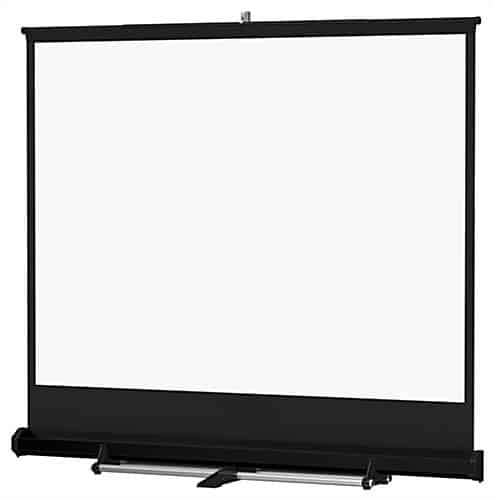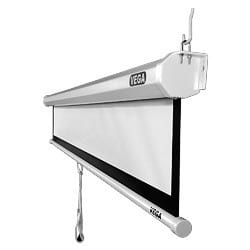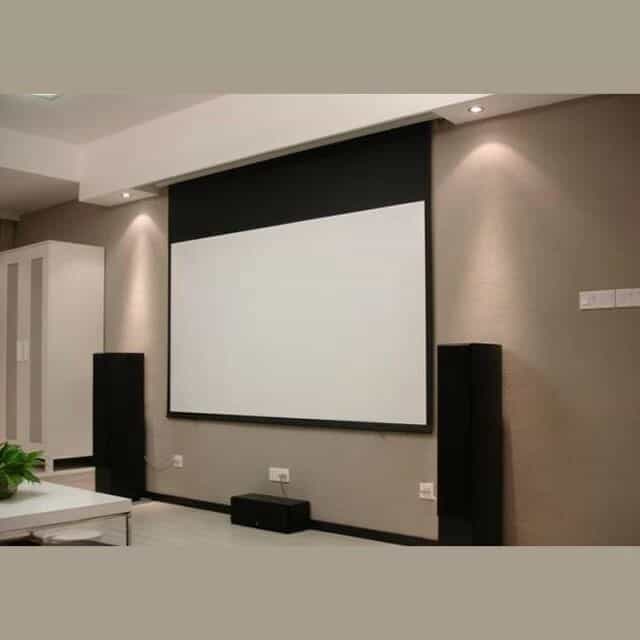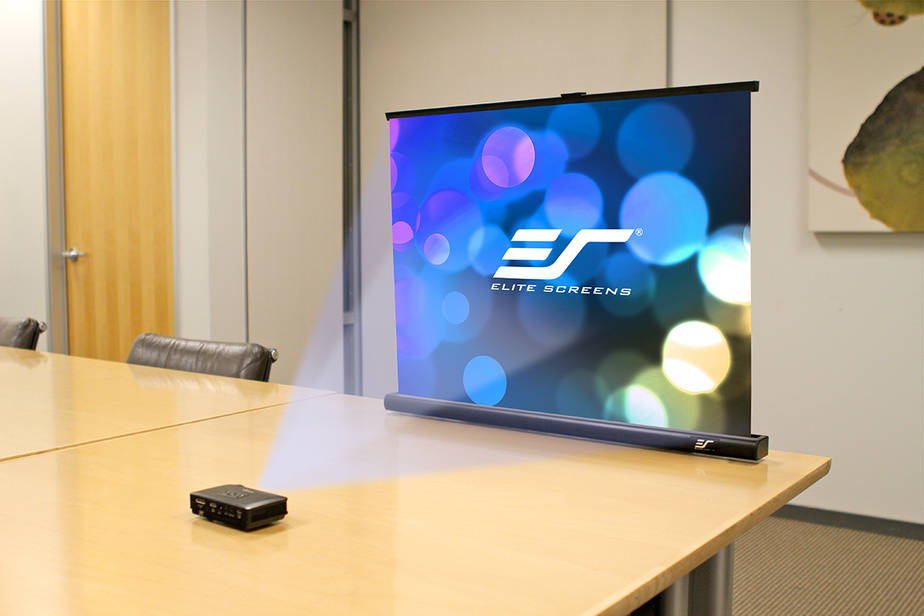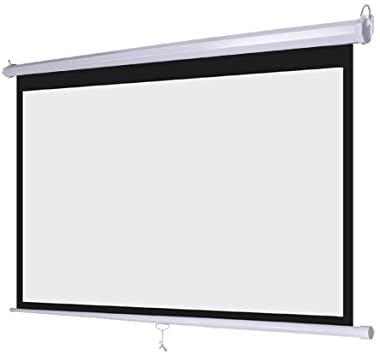A projector works great as it has a corresponding screen to work together with. Compared to a plain white wall, a screen will be superior because it’s intended to precisely display every last part of their projection, especially if it’s in HD and ultra-hd. This is only because screens comprise a special coat using reflective properties which help make the projection come out clear as though you’re taking a look at an HDTV in the place of at a wall.
Standard wall paint isn’t enough to properly display projections or projector images at the very best brightness and caliber. Several types of projector Screens will also be available to fulfill different needs of the viewer. They are now sorted by screen type and bracket type.
| Effectiveness | Installation | Price | |
| White Wall (No Screen) |
Compared with the picture projected on the screen, the picture quality is not so good |
No additional installation needed; Needs a clean wall |
No additional costs |
| Fixed Frame Screens-Basic | Best image quality and flattest image surface; Suitable for projectors with any throw ratios | Additional installation needed; Needs a clean wall | |
| Fixed Frame Screens-Light Rejecting | Suitable for well-lit rooms and/or for ultra-short throw projectors | Additional installation needed; Needs a clean wall | More expensive compared to manual one |
| Ceiling (Pull-Down) Screens-Manual | May cause slight distortions with ultra-short throw projectors at a level greater than floor rising screens | Additional installation needed | |
| Ceiling (Pull-Down) Screens-Electric | May cause slight distortions with ultra-short throw projectors at a level greater than floor rising screens | Additional installation needed; Needs a power supply | More expensive compared to manual one |
| Floor Rising Screens-Manual | May cause slight distortions with ultra-short throw projectors | No additional installation needed | |
| Floor Rising Screens-Electric | May cause slight distortions with ultra-short throw projectors | No additional installation needed; Needs a power supply | More expensive compared to manual one |
Electric Projector Screens
Essentiallythis projector screen functions by being a screen it’s possible to bring down or hide up at the press of a button. It is digitally and automatically operated to gift itself or hide itself like an electric door. An electric projector screen offers an appearance of professionalism for your demonstrations and movie-viewing experience in home cinema stipulations. This is because it’s a screen it is possible to operate by remote control. It showcases a stylish, sleek design and works in a single place for storage advantage.
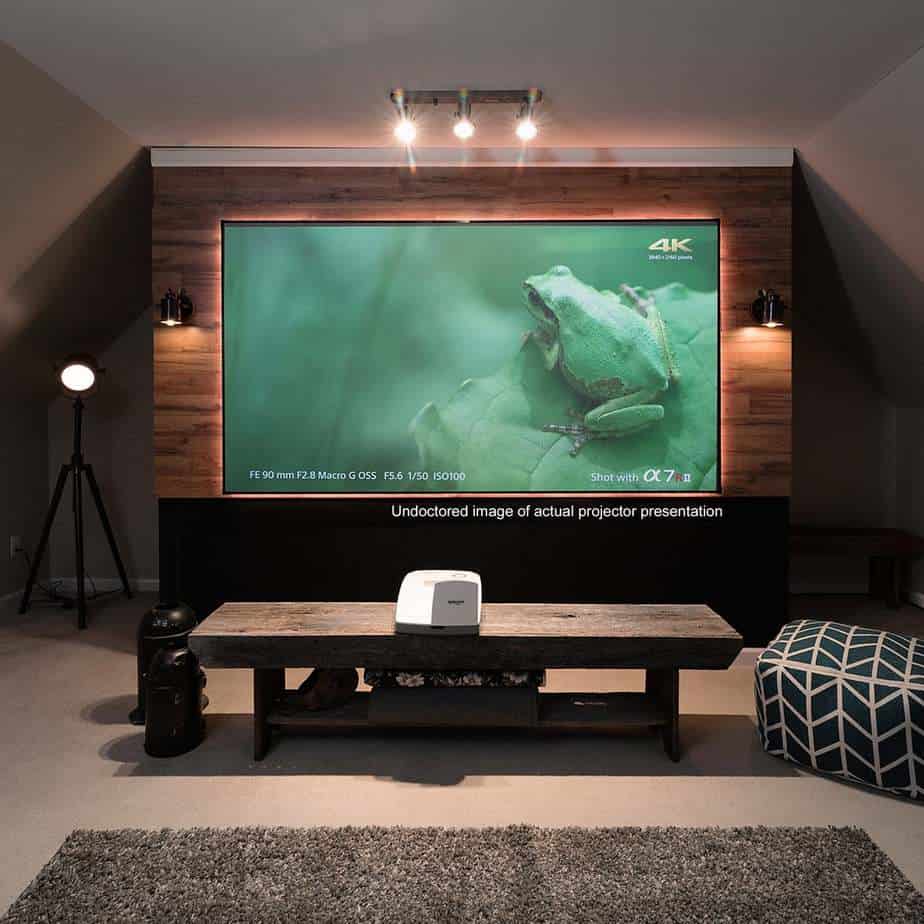
They can be obtained as either non-tensioned or tab-tensioned screens. In addition, it is typically hidden by way of a slot set in the ceiling as ceiling mounting. You will find projectors of the sort which come with a wood trimming-up shirt, which helps camouflage the screen once it is not used and they’re a great alternate to recessed ceiling climbing. All these projector screens on average operate using 100 volts. However, there are models available that run using 220 levels of power instead. Additionally, there are screens you can operate by remote controller like you’d an HDTV.
Fixed Frame Screens
A fixed-frame screen can not be wrapped down and up manually or electronically. They’re fixed on a framework, thus the definition of. They’re for seminar rooms and home cinemas who have enough space to accommodate a forever fixed frame screen. This arguably makes this screen type the very elite of most screen types available because of the commercial viability.
After all, a picture theater typically has a fixed screen arrangement. Home theatres look more”theatrical” if it has enough space to adapt this screen type along with your own HDTV and media participant hinges.
Fixed frame screens will also be renowned for their durability. They last the longest since they lack moving parts and aren’t always being rolled up and down among usage. In addition you won’t have the bends in those screens because they’re not bent. They’re just permitted to sit there in their glory till they’re allowed to be used.
Additionally, it is because they truly are on constant display that they offer the ideal picture quality which isn’t marred with the needs of storage, mobility, or getting placed away. You have a lot more choices for those screens to select from exactly because of their easy accessibility.
Portable Projector Screens
For those who get a portable pico or pocket projector it makes sense that you get a portable projection screen to cooperate side it therefore that you wont be forced to look for white or plain walls to project your pico pocket every moment.
A portable projector screen is often as big as 40 inches, so especially when it comes to 4K H D projection that requires more pixels for your buck. They include a mobile projection screen rack that is lightweight, durable, and collapsible so that you could readily carry both screens and stand around.
They’re mostly for conference room use but some might also be useful for both indoor and outdoor applications as well. While searching for a mobile screen, search for one that’s made for quick setup so that it’s not really a hassle to set the rack and screen together at every conference, picture viewing, or gathering.
It’s used mainly by people who would like to do demonstrations on the go, especially pitchmen and amateurs. An outdoorsy portable screen must be hardy and hardy as a way to withstand the harsh elements and also a number of usages when push comes to shove.
An inflatable projector screen is apparently the one you can inflate. They are like screens drive-in picture theaters, which permit one to relish an indoor-theater-quality picture when driving with your car in a backyard lot–it is the very best of both worlds, so isn’t it?
At any rate, it is possible to make your own drive-in or outdoor theater in your own garden without attaching white sheets at the trunk of your home by buying this type of projector screen. What’s more, the image quality of a screen is definitely more advanced than that of white bed sheets.
Inflatable projector screens enable one to watch something outside without fretting about the mount sinking into your yard or grass. Many mobile or wheeled mounts for projectors function only on floors or concrete. For a reasonable price, you also can find a self-inflating screen to stay on its own in minutes.
You may also adjust it to fit various screening angles without adjusting your own projector’s keystone correction or lens shift. These screens have amazing image quality and are produced from a material that may withstand the outdoor elements as well as temperature extremes of this cold and hot variety.
Projector Screen Paint
By the way, the quality of one’s projector screen depends on the quality of paint used on it. The exceptional coating dictates how reflective their screen surface is if push comes to shove.
Rather than getting a screen with reflective screen coating, you should make use of this newer alternate to screens to create a homemade (DIY) screen that’s much less expensive than a lot of the screens available here, even when we’re speaking about the fixed frame screen.
Or you’ll be able to stretch a canvas over a framework together with it with screen paint painted to show it on a projection screen. In the event that you lack permanent wall space to utilize this paint, you can paint it using a large plank or other objects to generate a mobile canvas projector screen of sorts.
Your choices are unlimited! Just take note that a genuine projector screen will always have superior viewing quality compared to canvas painted using projection screen paint, however, it’s still better than having a wall-mounted using ordinary paint painted onto it.
Manual Projector Screens
Rather than using electronics to place it up or bring it down, you can manually place this up or put it up yourself. It’s definitely among the cheaper projector screens around, right close to the fixed frame screen.
They work with a pedal in the base of the screen to allow one to pull the screen up or down like window blinds. Many modern manual projector screens also have a restricted yield feature so that it might slowly return into place rather than rollup quickly just like blinds.
The cause of this is since the quick-rolling mechanism could damage the integrity of the screen itself, which isn’t necessarily an issue along with your blinds but a concern when it comes to seeing movies and demonstrations at full HD quality.
They are very similar to their electric or electronic counter part however that time around, they use manual pulleys to get the job done. They are sometimes ceiling-recessed, ceiling-mounted, or wall-mounted like electric screens too. They’re much lighter compared to electric projection screens exactly because they lack the more electronic components that produce those much heavier to take care of.
Rear Projector Screens
A rear projector screen or rear projection screen can be just a screen that offers amazing brightness, contrast, and viewing angles exactly because the projector is placed from the screen, shooting the audience a la a TV screen.
The projector screen is translucent as well as the projector itself becomes more unobtrusive without you having to set an aisle in between the chairs of one’s audience to generate way for its projection light. The brightness of this screen is elevated as it’s getting direct projection from the nearby projector that’s projecting its image from behind it.
Shooting towards the viewer delivers this screen a much more TV-like texture, with all the brightness emanating from behind the screen rather than in front of it. It’s the type of lighting diffusion technology that regulates the light path in order to distribute the sharpest and brightest of graphics unto a predefined viewing zone.
No need for multiple alterations for keystone correction, lens shift, or zoom shift. You won’t even need to bargain with throw ratios or people obstructing the projector lighting up to this particular dependable installment either. It’s actually good in dealing with bright-lit surroundings with loads of ambient light to boot.
As an instance, you can paint a white wall with all an reflective jacket screen paint and make it in your projection wall of infinite size and aspect ratio variations. If you’re creative and creative enough, you can make your own personal screen with just a can of projector screen paint available in hand.
A normal projector screen with a massive size will cost you hundreds simply to get it sent out or transferred independently.
If you might have canvas fabric and also a frame it is possible to take advantage of, why make use of shipment and extra expenses? You might even want people to install it. Why be determined by other people when you can create your own personal screen your self?
Just remember that if you are making the effort to turn your DIY screen into something comparable to a commercial screen, a bit of effort on your own part may be called because extends outside get yourself a gallon of roller and paint to paint a screen how that a fixed-frame screen.
As an example, you’ll need to know about black-out material, rear projection diffusion technology, and also the pros and cons of vinyl versus fabric screens.
Different types of projector screens by mount type
Here are the different types of projector screens from mount type.
Ceiling Projector Screens
This projector screen mount type is mounted on the ceiling. It could possibly be a manual one you can pull down like dividers or a power one that you need to activate to be able to pull . It can also be utilised in tandem with the wall but that’s another kind of projector screen that you can read about more below. This screen is permanently installed unto your ceiling through a mount. If it stops working, you’ve got to clear away the mount and then exchange it with a fresh one.
Yet, they more than cosmetics because of this future hassle having its daily convenience. At the push of a button or the pull of a cord, you’ll be able to find a screen ready for the projector to project upon, whether it’s from the back or upfront.
Most ceiling-based mounts are of the ceiling variety so that after the screen isn’t being used, you can certainly hide it from view and receive back all that space for additional appliances or equipment. Many ceiling mounts are for electric projector screens, like the casing has been mounted within the ceiling arrangement itself and whatnot for ultimate convenience.
Floor projector screens will be the reverse of ceiling projector screens. They are installed on to the floor instead of the ceiling that this time round. The most usual floor projector bracket may be your one using a mechanism which allows it to rise from the floor such as a hidden screen.
It employs exactly the exact same idea like an electronic ceiling screen, yet this time it climbs upwards from the floor instead. It’s really a terrific alternative to tripod screens which can be regarded as milder than that space-saving marvel. An flooring rising screen is much simpler and more lightweight to shoot down or setup when compared to bulky tripods.
Another thing that is great about a floor rising projector screen is that it is available from 1 piece. That you don’t have to assemble yourself like IKEA furniture. Some don’t also include a carrying case as the grip is mounted unto the base of the screen for that sake of improved access when push comes to shove on.
All you need to do is put the feet up to the screen and you are all set. You just twist the feet around so they’re perpendicular to the screen itself. After setting the feet up, you can pull the screen up.
Folding frame projection screens, also called Truss projector screens, are screens you may fold like a folding seat for greater mobility, storage, and accessibility. A typical folding framework projector screen in present times supports 1080p resolution or 4:3 video.
To put it differently, it supports both the 16:9 videos and old lower resolution video at the exact same time which means that you may delight in both vintage and modern movies in addition to television series.
Additionally, it must have–for example–a viewable elevation of 108 inches, also a viewable diameter of 144 inches, and also a viable angled diameter of 180 inches which you can perfectly fit in to a comfortable throw space with your projector. It’s about finding a good fit between your Truss projector screen along with your most likely mobile projector also.
If you have a folding frame screen it is sensible to own a pico projector to work with its own image onto it for the traveling salesman on the move. On the other hand, you may also utilize this screen type to the interest of viewing pictures in a home cinema regardless whether or not it’s front or rear projection too.
Outdoor Projector Screens:
Many projector screen types can fall under the outdoor projector screen umbrella. Any tripod, cushioned, or folding frame projector may double as an exterior projector as long as they’re designed to withstand the elements or find a solution to stay upright in grassy knolls or perhaps the dirt ground.
The single-most joining element of a outdoorsy projector screen is its own hardiness or durability. You would like something which could survive and certainly will deal with rough handling as this screen is open to these weather.
You desire to have an outdoor screen mount which includes a solid black frame as it does not only boost the visual quality of this projected image in terms of color contrast and saturation but can deal with the harshness of our mother earth, by the blistering sun to precipitation in all forms.
It ought to have the ability to resist temperature extremes without even wearing down or corroding. It should be produced of non-corrosive material, even if you would like to place it up then take it down after every viewing. It ought to be considered a miniaturized consumer edition of the screens at drive-in theaters without a doubt.
Tabletop Projector Screens
As its name implies that this projector screen might be installed onto your own tabletop such as a picture frame or even a painter’s canvas.
It’s a good alternative to the folding framework or Truss projector screen in terms of portability but now round you could need to forfeit a little in terms of projection size. It’s mostly used for on the go picture seeing a viewer or portable presentations at multiple conferences across different states. It has a screen that’s larger than the greatest HDTV but maybe not so large you can not bring it along with you via briefcase.
It’s also not unusual for you to wind up getting a screen that’s foldable or is available at a spring roller variant too. It’s all for the interest of maintaining with the freedom feature. These screens can also be used in home in home cinemas and what not within an extra screen along with your vintage CRT and modern HDTV monitors.
This wayit lies in precisely the exact same table space as the others of one’s screens and press players, which makes it linked to a matrix switcher. That is especially true if it is really a back projection screen and the projector can be connected to your own matrix switcher setup.
Tripod projection screens are known to be milder than their floor projection screen counterparts. The reason for this is because it’s supposed to stand upon its own tripod legs, which naturally take up more space to encourage the weight of the screen it is holding.
This as compared to floor projector screens which grow up from the floor and are backed with precisely the exact same floor at the exact same time, hence saving distance in regards in tripod legs.
It can be a type of portable projector as long as it has a screen size you can carry with you to the go. This is a more permanent fixture or appliance at house if it gives a screen that is larger than your typical chalkboard.
The beauty of a tripod mount for projection screens is they permit one to steadily put your screen anywhere you would like, thereby limiting the requirement to use any lens shift, zoom switch, or keystone correction with respect to your projector to produce its projection fit.
A wall-mounted projector screen is an average of some thing like setting lifting or up the fixed frame screen on the wall so you get a bigger surface to work out your video or image on that’s not merely whitewall.
The screen is normally rectangular now but once upon a time throughout the 4:3 aspect ratio era of tv something squarer has been common. Now, you can mount your own projector screen like you’d mount your flatscreen TV–like the oversized dark canvas picture frame.
A wall bracket makes the most sense as a projector has been apparently supposed to project pictures on a wall or even a screen that is directly infront of it. Your screen wall mount should be somewhat longer and girthier to adapt back projection.
Otherwise, you might need to resort to putting your screen on an open window or hole in the wall where the projector can project from it.
Wall And Ceiling Projector Screens
You are able to use your ceiling and wall mount in tandem as a way to develop a more steady and balanced mount for the screen. The theory here is to lessen potential jiggle or accidental lumps that will make the screen angle go askew and also mess up your viewing experience.
A wall mount alone is sufficient to simplify your screening problems as projectors job their images in an easy, spotlight-like manner automatically option. These screens can either be manually or electronically installed.
Additionally, a wall and ceiling projector screen is an appealing prospect because it’s a permanently installed screen which may be ceiling brightly colored, ceiling-mounted, wall-mounted, or more aerodynamic.
A ceiling bracket screen can double as a wall mount if you’re using both mounts at exactly the same time to place your projector screen up properly. The major difference is the fact that the walls aids the ceiling with the mounting and also vice-versa, giving the plastic or cloth that a more stable anchor and tautness that improve projection caliber in terms of surface smoothness and stiffness.
You might need to get the used bare-bones projector screen mount or make up your own mount with everyday items at home. A bracket is more challenging to make on your own than a screen though, which means you should probably be a DIY enthusiast having a desktop in bracket construction to make this work.
Your mount is often as easy as a whiteboard bracket with wheels repurposed for use with a screen to as complex as a inflatable one used for outdoors viewing. It is possible to make ceiling mounts for drop down screens should you wish of course, if you should be competent.
Mounting for a projection screen is usually easier if they’re commercially made versus DIY. Of course, that is dependent upon how good you’re in DIY projects. If you’re an engineer, you ought to have the ability to produce a tripod, fixed frame wall mountor manual roll-down ceiling screen bracket. You ought to really be able to save hundreds of dollars alone out of not investing in shipment.
A fixed frame screen you can hangup on almost any wall.
A dining table mount can also be rather easy to make for DIY enthusiasts.
Conclusion
Projection screens are better than walls as a result of their optical coatings that enhance their reflective qualities, which consequently results in demographics that are clearer when all is said and done, like you’re looking at an HDTV monitor that is remarkably large. The major point of a screen is to reflect the exact projection light to ensure a sharper image rather than a faded one.
White walls lack this specific reflective property. It’s true that you may work with a wall and end up getting a watchable projection. It’s like having a wrench instead of a hammer to attack a nail down. You certainly can do it however, the hammer is designed todo hammering better.

